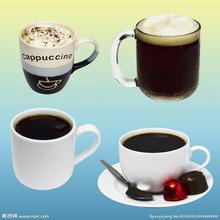Flavor and taste of Ecuadorian boutique coffee beans introduction to the characteristics of the manor producing area of San Cristobal
port of Guayaquil
The port of Guayaquil is Ecuador's largest seaport. It faces the Pacific Ocean and backs to Mount Santa Ana. The nearby island of Pune serves as a natural barrier to protect the harbour from storms. There is a dock to the south, more than 900 meters long. In the harbor, ships from different parts of the world are moored, flying various flags. The port railway leads to Quito, the capital, and a series of highways connect Quito with other cities in the country. Bananas, cocoa, coffee, cotton and other products from all over the country are collected and distributed here. Guayaquil also played an important role in the history of friendly exchanges between the peoples of China and Ecuador. As early as the 18th century, Chinese clothing, textiles and other goods were transported to Ecuadorian cities through Guayaquil. In August 1978, the Chinese freighter Jialing River arrived here for the first time. Most of the imports and exports of the two countries are also transshipped through Guayaquil.
Cuenca
Cuenca City, Eritrea's third largest city, located in the southern plateau, population 300,000, elevation 2500 meters.
National Symbol Editor
name
The Republic of Ecuador (Spanish: La República de Ecuador) Spanish means "equator." Also known as "equatorial country","banana country". [3]
flag
The Ecuadorian flag is rectangular and has a ratio of length to width of 2:1. The flag consists of three rectangles, yellow, blue and red. Yellow accounts for 1/2 of the flag surface, red and blue each accounts for 1/4. It has a national emblem in the center. Yellow symbolizes the wealth, sunshine and food of the country; blue symbolizes the blue sky, the sea and the magnificent Amazon River; red symbolizes the blood of patriots fighting for freedom and justice. [3]
national emblem
Coat of arms of Ecuador
Coat of arms of Ecuador
The coat of arms of Ecuador, adopted in 1900, resembles the coat of arms of Colombia. A fierce "American Condor" vulture spreads its wings above the national emblem. It is Ecuador's national bird, symbolizing sovereignty and independence. Ecuador's national emblem has a unique design concept, fully demonstrating the national flavor: Ecuador's highest peak, Chimborazo Mountain, is covered with snow. Against the blue sky, it stands towering on the Pacific coast. The trees at the foot of the mountain are verdant. A big river winds out from the depths of the mountains and gradually flows into the blue sea. An ecuadorian pride in south america's first steam-powered ocean-going vessel lies at sea. Above the snowy peak, a Mayan culture symbol of the "sun in May" radiant. On both sides of the sun marked with March, April, May, June month symbols "Zodiac twelve officials", representing the Ecuadorian people in 1845 to maintain national independence against foreign invasion of the difficult years. The bar at the bottom represents the national institution of the republic, a symbol of justice and authority. As coffee is consumed by people all over the world, the world coffee industry is moving towards mass production mode, and San Cristobal's small and uncertain coffee industry is in trouble, and it is likely that it will eventually be abandoned without profit. It wasn't until the early 1990s that the Gonzalez family bought Hassenda Coffee Plantation. The local microclimate created by the Humboldt Current, intense equatorial sunlight, and rapid temperature changes (43 ° C at sea level and 10 ° C to 16 ° C at 275 meters above sea level) provided unique favorable conditions for the Gonzalez family to expand coffee plantations. The Gonzalez family doubled the size of the coffee plantation by clearing the early land.
Due to the unique role of the Galapagos Islands in the historical process, the Ecuadorian government has designated the islands as a national park, no longer allowing land to be reclaimed for new agricultural land, and prohibiting the introduction and use of fertilizers, pesticides, herbicides and other chemical agents, so the coffee produced in the Galapagos Islands is recognized as a natural product. Thomas was born in 1487 on the banks of the Duro River in the Spanish province of Soria. He was the fourth bishop of Panama at that time. He was ordered to Peru. When his ship set out from Panama on February 23, under the impact of a strong current, they were carried to an unknown sea in the outer ocean. On March 10, an island in the Galapagos Islands was discovered. With only two days of fresh water left on board, the sailors landed in lifeboats and found plenty of seals, turtles, giant tortoises that could carry people and viper-like iguanas on the island, but they could not find fresh water, so they headed for another larger island more than 20 kilometers away. As there was still no wind, it took them days to get there, the water ran out quickly, and they had to starve, including the horses on board.
When Thomas and his crew landed on the island, they frantically searched for water and were so thirsty that they squeezed juice from the fat petals of cacti to drink. Finally found water in a ravine in a rock. Thomas attributed it to God because it was Good Friday and they had celebrated Mass piously before setting out in search of water. But Thomas would never have known that the island they landed on was the only one in the Galapagos that had plenty of fresh water. It was San Cristobal today

(Saint Cristobal)
Important Notice :
前街咖啡 FrontStreet Coffee has moved to new addredd:
FrontStreet Coffee Address: 315,Donghua East Road,GuangZhou
Tel:020 38364473
- Prev

Special flavor of Panamanian Cupid Coffee Manor flavor and taste characteristics of boutique coffee beans
Land resources Panamanian land use: arable land accounts for 8.9%, permanent pastures account for 20.0%, forests and woodland account for 43.0%, others account for 28.1%; per capita arable land accounts for 0.6 mu. [2] Panama is rich in mineral resources, but it is not exploited much, and the scale of the mine is relatively large.
- Next

Introduction to the characteristics of Uganda Fine Coffee Bean Flavor and Taste Manor
The people of all parts of Uganda resisted the British aggression tenaciously. In 1893, Britain sent troops to occupy the Kingdom of Bunioro, and King Kabarega led some of the people to wage guerrilla warfare for six years. In 1897, King Mwaanga of Buganda raised his army against Britain and later joined Kabarega in the Rango region. In April 1899, the two kings were captured and the uprising failed. To make it easier to rule
Related
- Detailed explanation of Jadeite planting Land in Panamanian Jadeite Manor introduction to the grading system of Jadeite competitive bidding, Red bid, Green bid and Rose Summer
- Story of Coffee planting in Brenka region of Costa Rica Stonehenge Manor anaerobic heavy honey treatment of flavor mouth
- What's on the barrel of Blue Mountain Coffee beans?
- Can American coffee also pull flowers? How to use hot American style to pull out a good-looking pattern?
- Can you make a cold extract with coffee beans? What is the right proportion for cold-extracted coffee formula?
- Indonesian PWN Gold Mandrine Coffee Origin Features Flavor How to Chong? Mandolin coffee is American.
- A brief introduction to the flavor characteristics of Brazilian yellow bourbon coffee beans
- What is the effect of different water quality on the flavor of cold-extracted coffee? What kind of water is best for brewing coffee?
- Why do you think of Rose Summer whenever you mention Panamanian coffee?
- Introduction to the characteristics of authentic blue mountain coffee bean producing areas? What is the CIB Coffee Authority in Jamaica?

